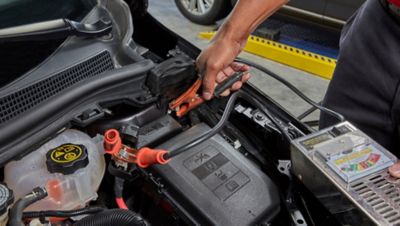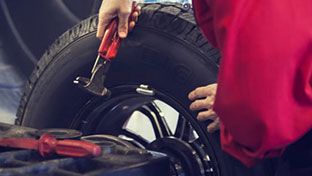Knowing what obstacles you may face off-road will help prepare you to navigate through them. Tires have the most traction when pointed in a straight line, so it's important to always know which way your tires are facing.

DRIVING DOWNHILL
- First things first – before you begin your downhill climb, get out and scout your descent so you can prepare for whatever may be in your path.
- Know your tires' position. Don't rely on your steering wheel to tell you which way your tires are pointing because it could be completely turned around. The best way to tell your tires' direction is the old-fashioned way – stick your head out the window and look at them. Make sure your wheels are properly aligned with our wheel alignment service.
- Put your vehicle in 1st gear (see Part 1: Gears for more information).
- Keep your tires pointed straight downhill, and use minimal (or no) braking. As described in Part 1, 1st gear gives you a lot of natural engine braking, so you shouldn't need to brake much, if at all.
DRIVING UPHILL
- Look behind you and determine your "back-up plan". That way, if you are unable to make it up the hill, you'll know what you're reversing into.
- Put your car in 3rd gear (see Part 1: Gears for more info).
- Keep steady pressure on the gas pedal. How hard will depend on the severity of the terrain.
- Keep your tires straight. If you need to do the window test, do it before you start climbing.
- Build steady momentum on the flat and bottom third of the hill.
- Maintain a healthy momentum in the middle of the climb.
- Ease off the gas in the top third of the climb if traction is being lost. By backing off, you'll get less torque and more traction. You'll also want to ease off the gas at the top of the hill because you don't want to launch the vehicle over the crest of the hill, especially if you don't know what's on the other side.
FAILED CLIMB
- Know your tires' position. Remember, you can always do the window test if needed.
- Left-foot brake to stop spinning your wheels, select reverse and release the brake. This step is critical, so study it carefully. Brake-stop-reverse. Never roll backward using the momentum of the car.
- Keep your tires straight while reversing, and be prepared to use the gas pedal if necessary. If the incline is steep and you begin to slide, you may need to apply a little throttle and accelerate to regain traction and steering control of the vehicle.
FAILED DESCENT
- Make sure your vehicle is in 1st gear.
- Keep tires pointed downhill (counter steering if necessary).
- If you begin to slide, you may need to apply a little throttle and accelerate to regain traction and steering control of the vehicle.
SIDE SLOPES
- Put your car in 1st gear.
- Gently use your controls – no sudden movements.
- Prepare for the worst – if you feel like you're going to roll over, steer downhill and accelerate until you regain control.
- Avoid any uphill bumps and downhill holes to maintain traction and balance.
- Keep your body level with the seat. In other words, don't be tempted to turn your head upright. You need your eyes to stay even with the car's slant so you can maintain an accurate point of view and be able to react accordingly.
RUTS
- Know your vehicle's ground clearance before you drive through a rut, so you don't damage critical components on the underside of the vehicle. In simplest terms, drive so that the low point of the vehicle is away from the high point of the ground.
- Keep the direction of your front tires in mind at all times. They should be pointed straight ahead whenever possible.
- Depending on the surface you're navigating, "sawing the wheel" may be a consideration (See Part 2: Controls for more info). Using this technique on the appropriate surface can result in gaining the extra traction you need to keep you moving forward. For example, sawing the wheel in a muddy rut can help you dig down to harder material below, gain traction and keep moving forward. However, using this technique in a soft, sandy soil with no "bottom" will only result in digging yourself down to a point where you become hopelessly stuck.
- The highest gear that the vehicle is capable of going up a hill or through mud in is the gear you're going to use when you approach low traction situations like these – typically 3rd gear in an auto transmission.
- When you're ready to get to higher ground, look for places where the ruts are less deep. If no place exists and the sides of the rut are too steep to negotiate, good old-fashioned digging is probably your best bet. By placing extra dirt in front of your tires, you'll have the height you need to get out of the rut and onto more even ground.
CROSSING DITCHES
- Plan your crossing before you commit.
- Always cross ditches at a 45-degree angle. This approach allows tires to cross one at time, giving you the most control and ground clearance.
- Vehicles have more parts sticking out from the back than from the front, which means just because you clear the front half of your vehicle, you're not guaranteed to clear the rear.
Read more off-road driving tips – Part 2: Taking Control and Part 1: Gears.
Check out the off-road video featuring the BF Goodrich Mud Terrain boulder crawl.
Before you head out on the open road, be sure your off-road ride is properly lubed with our fast and affordable oil change service.

